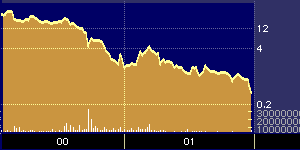
Net2000 IPO Jumps in Opening Trading
Net2000 IPO Jumps in Opening Trading
by Hal Plotkin
Silicon Valley Correspondent
Although Net2000 Communications Inc.’s {NTKK} initial public offering has already caught fire Tuesday, several analysts warn that profitability is proving elusive for many similar firms in the same sector.
Shares of the company have already jumped in their debut, passing 30. Late Monday, Net2000 priced its 10 million shares offering at 20 a share, at the top of its revised target range of 18 to 20 a share, and above its initial filing price of 12 1/2 to 16 a share.

Net2000 Post-IPO Stock-Performance Chart
“There are certainly too many cows grazing in the top cities,” says Lisa Pierce, vice president at the Giga Information Group, in San Jose, Calif. “I would urge caution.”
Herndon, Va.-based Net2000 is a competitive local exchange carrier (CLEC) that started out as a sales agent for Bell Atlantic Corp. {BEL}. CLECs compete primarily against each other and against incumbent local exchange carriers (ILECs), also known as Baby Bells, selling broadband digital subscriber line (DSL) services capable of carrying voice, data and video transmissions.
The company transitioned out of its sales agent role and launched the Net2000-branded service in July 1998, initially focused on serving business customers in the Boston to Washington corridor. Net2000 plans to offer DSL services in an additional 14 of the top major markets in the United States as it completes its build out over the next 24 months.
Like many CLECs, Net2000’s business strategy involves going after business customers, in this case, firms with 50 or more access lines.
“That’s not at all an unusual business strategy,” says Steve Koppman, an analyst with the Gartner Group. “All of the CLECs are after business customers.”
Several industry analysts warn, however, that CLECs such as Net2000 are showing few if any profits, despite their fast-growing customer ranks.
All told, the dozens of CLECs now in business are doubling their market penetration each year, according to the Gartner Group.
The fast growth led Merrill Lynch to initiate coverage of several leading CLEC firms on Feb. 10, when it issued either intermediate or long-term “buy” ratings on the stocks of Allegiance Telecom Inc. {ALGX}, Covad Communications Group Inc. {COVD}, McLeodUSA Inc. {MCLD}, NEXTLINK Communications Inc. {NXLK} and NorthPoint Communications Inc. {NPNT}, among several others. Merrill Lynch cited strong sales growth among the CLECs as the main rationale for its move.
But, as I Love Lucy’s Lucy Ricardo discovered when selling salad dressing 40 years ago, strong sales don’t a profitable business make. Lucy, you may recall, was startled when her husband, Ricky, pointed out that the more she sold, the more money she lost.
“It’s not hard to get customers,” Koppman says. “But it may be difficult to make a profit on those customers.”
“There’s a really big problem with a squeeze in the last mile,” adds Jeanne Schaaf, senior analyst at Forrester Research, based in Cambridge, Mass. “Most times, the CLECs are just reselling the tail circuits of the ILECs.”
Put in plain English, that means firms such as Net2000 face limitations on the services they can deliver to customers based on their need to deliver those services over copper lines that are owned and leased from the incumbent carriers. CLECs typically must pay the ILECs somewhere around 80 percent to 85 percent of the retail charge for access to the lines they need, which the CLECs then resell to end users, often at a discount to the incumbent carrier retail prices.
“The issue is that all of these folks don’t add too much to the market,” Schaaf says.
In New York, for example, there are now more than 20 CLECs selling essentially the same services, according to the Yankee Group, based in Boston.
That reality hasn’t dampened investor enthusiasm for CLEC stocks, though.
At least, not yet.
Take, for example, Santa Clara, Calif.-based Covad Communications, which went public on Jan. 21, 1999 with shares initially priced at 18 each. The stock has been trading near its one-year high of 100 in recent sessions, despite 1999 losses that totaled $195.4 million on revenue of $66.5 million.
Stock Graph”Losses like that are really not a red flag,” says Hongjun Li, senior analyst at Parks Associates, based in Austin, Texas. “In fact, in this industry if they did not have big losses, Wall Street might think the company is not being aggressive enough.”

Covad: Post IPO Stock Performance Chart
“The name of the game for these firms has been rapid and focused customer acquisition,” agrees Rob Rich, executive vice president of telecommunications research at the Yankee Group. “Most of these companies start out with significant losses.”
Rich says Net2000 has some advantages, despite the sector’s profitability woes. “Wall Street usually looks at the management team,” he says. “And Net2000 is pretty strong in that regard.”
Rich says Net2000’s chief legal counsel, Lee Weiner, is a widely respected industry veteran who knows the ropes when it comes to competing with sometimes uncooperative local carriers who, by law, must provide fair access to their lines and central offices.
“It’s very important for a company like Net2000 to have that kind of experienced legal talent,” Rich says.
Nonetheless, the consensus among industry analysts, if not financial analysts, is that Net2000, like most of its CLEC competitors, still has a lot of work to do to show it can become a profitable, stand-alone firm.
Several recent mergers in the industry, for example, such as the recent marriages between NEXTLINK and Concentric Networks, and McLeodUSA and Shiprock, are cited as evidence that profitability pressures are beginning to take their toll on the industry.
“That tells me cash flow is becoming an issue,” Pierce says. “The mergers among the CLECs means there’s very slim pickings right now.”
Pierce says she is also dubious that all the CLECs need to do at present is build up their customer ranks, at seemingly whatever cost, without regard to profits on the assumption that they will show up somewhere down the line.
“None of these companies have a lock on their customers,” Pierce says. “AT&T {T} got burned thinking they have a lock on their customers. I don’t see why it’s going to be any different for the CLECs. If someone offers their customers a savings of 20 percent or more, the customers will overcome their inertia.”
And that means once any euphoria surrounding Net2000’s IPO subsides, the firm, like its CLEC competitors, will still have to demonstrate a profitable business model capable of generating long-term investor returns.
Net2000 posted a loss of $22 million on revenue of $18.6 million for the nine months ended Sept. 30, compared with a loss of $8 million on revenue of $5.9 million for the same period a year earlier.
Web www.halplotkin.com


